Dell UltraSharp U2711: Quality has a Price
by Jarred Walton on January 22, 2010 2:00 AM EST- Posted in
- Displays
Dell U2711 Color Quality
We'll start with a look at the color quality of the U2711, broken down into two areas: Color gamut and color accuracy (i.e. Delta E). We'll start by explaining the former. Color gamut refers to the ability for a display to represent all of the colors in a defined selection of colors. In this case, we use the Adobe RGB standard to define the base gamut, and we measure the percentage of that standard that a display is able to cover - higher being better.
Delta E is the difference between a requested color and the color that actually appears on the display, with lower being better - i.e. the displayed color doesn't have a large delta relative to what was requested. If a display has perfect color accuracy, Delta E will be 0.0; in practice, anything less than 1.0 is nearly perfect and no one will notice the difference. A Delta E of 2.0 or less is the desired result after calibration, meaning no one color measures higher than 2.0 on our standard 24 color palette. Such a result would be fit for use in any professional imaging environment. Finally, while Delta E of around 4.0 is visible to the naked eye, it's really a question of reference points; if you don't have something better nearby and you're not going to print or view content on other media, a result where all colors measure 4.0 or less is very good.
So how does the U2711 do in these areas? First let's look at the charts, and then we'll discuss what they mean. We used the Graphics and Adobe RGB setting on the U2711, with brightness set at 36% (~200nits) and contrast at the default 50%.
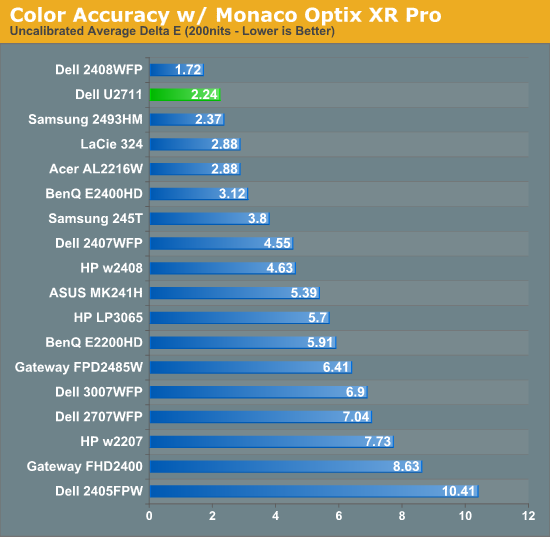
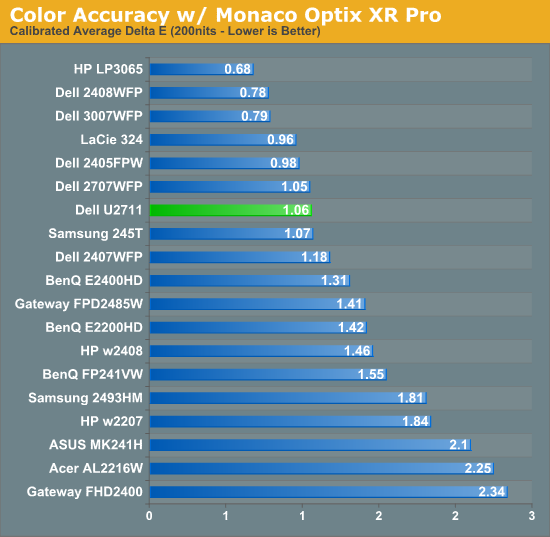
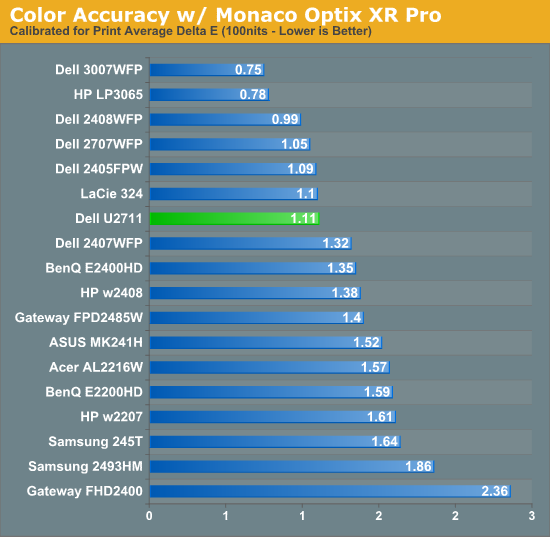
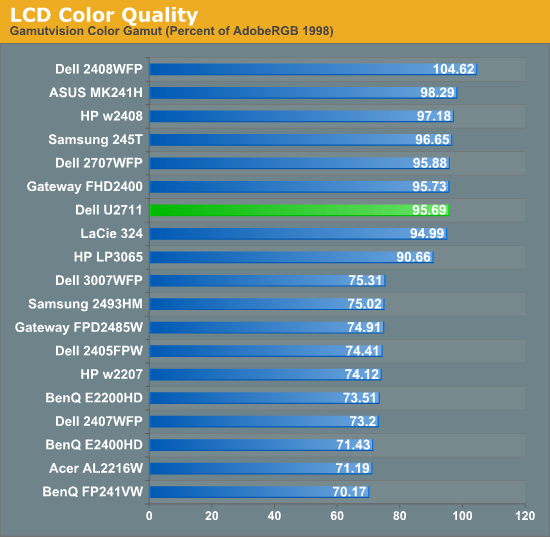
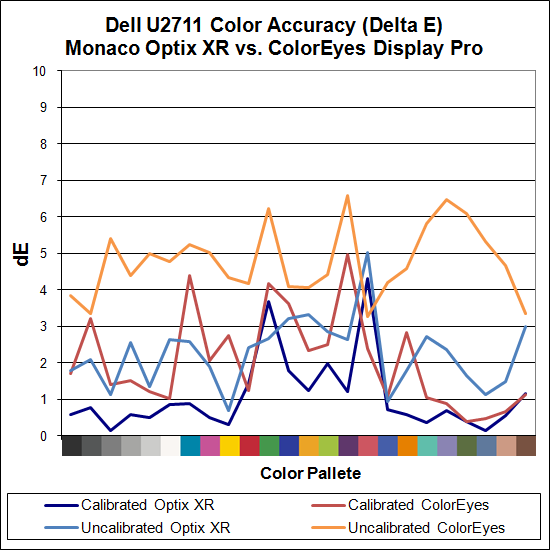
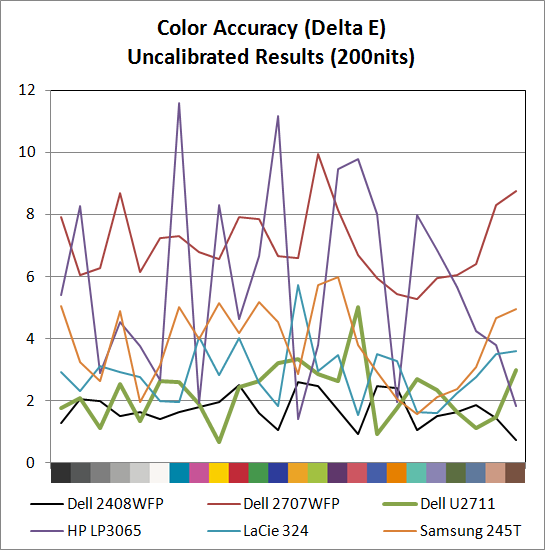
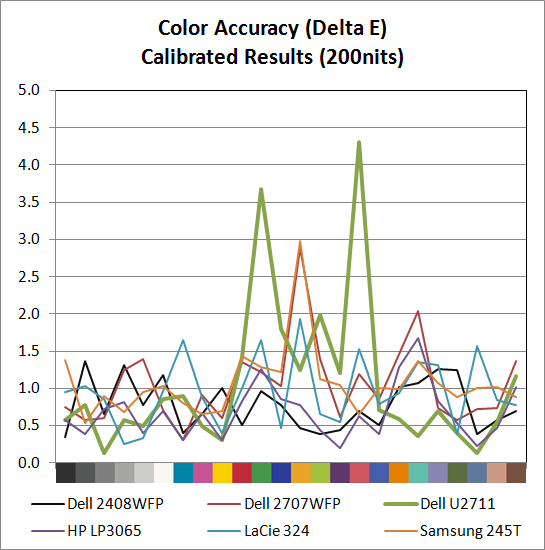
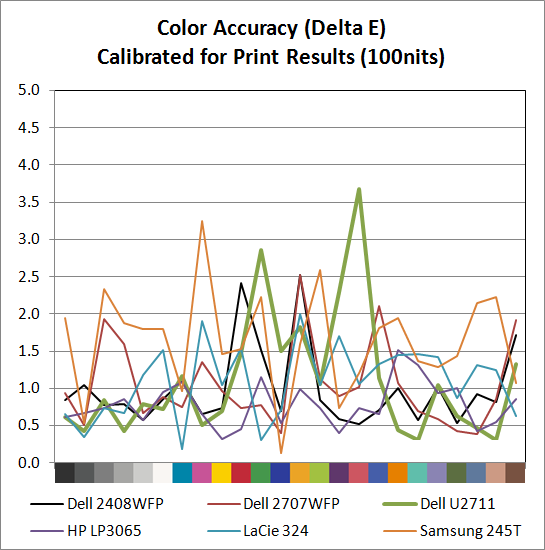
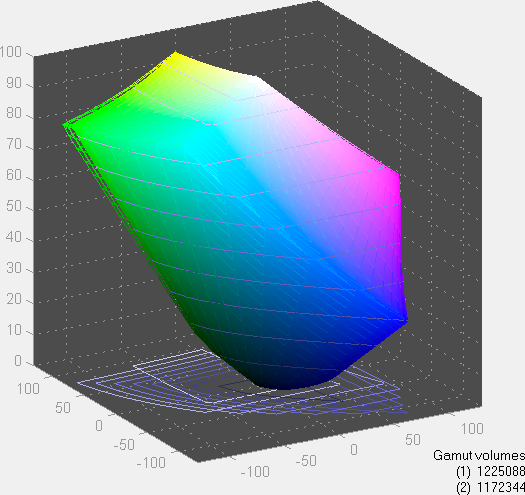
The U2711 scores extremely well in color gamut, and it achieves the 96% of Adobe RGB that Dell claims in their literature (not that most users would really notice the difference between any of the displays rated 90% to 105% - at least not after you eliminate the TN panels). Color accuracy on the other hand is a bit of a mixed bag. Dell ships a paper with test results showing the color calibration of each individual U2711, with the claim that the displays will have an average Delta E of less than 5.0 without any end-user calibration (when using the sRGB and Adobe RGB settings). Dell uses Minolta Color Analyzer CA210 and 32 test colors while we test with ColorEyes Display Pro and Monaco Optix XR Pro and 24 test colors, but our Monaco results confirm their claim. We're not sure why, but we continue to get better results using Optix XR Pro than with ColorEyes Display Pro.
As far as Optix is concerned, the U2711 achieves the rated Delta E of < 5.0 at just 2.24 without calibration, which is an excellent result. In fact the U2711 has no colors in the standard Gretag Macbeth 24 color palette score higher than 5.0 (and only reddish-pink scores a 5.0 measurement). The only LCD we've tested that did better is Dell's own 2408WFP (which also, interestingly enough, had an Adobe RGB color gamut of 105%). ColorEyes also gives an average Delta E of less than 5.0, but at 4.78 the score isn't nearly as remarkable, with nine color measurements well above 5.0. The uncalibrated (Monaco) results put the U2711 ahead of the HP LP3065, Dell 2707WFP, Samsung 245T, and LaCie 324 - and just about every other LCD we've tested.
Switch to the calibrated results and the U2711 doesn't impress quite as much relative to the competition. Monaco gives the U2711 an average Delta E of 1.06, which is great, but there are two results above 3.0 (the worst is reddish-pink again, this time at 4.31) compared to displays like the HP LP3065 where the highest measured Delta E is just 1.68. Dell's own 2707WFP, a three-year-old offering, also delivered a similar average Delta E but with only two colors above 2.0 (and still under 3.0). For a better LCD (i.e. not a TN panel), the results are really only slightly above average. It is possible different calibration software would achieve a better end result, but really we're talking about a "problem" that only the most demanding users are likely to ever notice.
Color Consistency
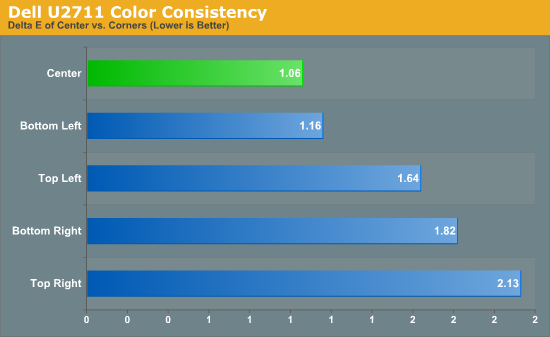
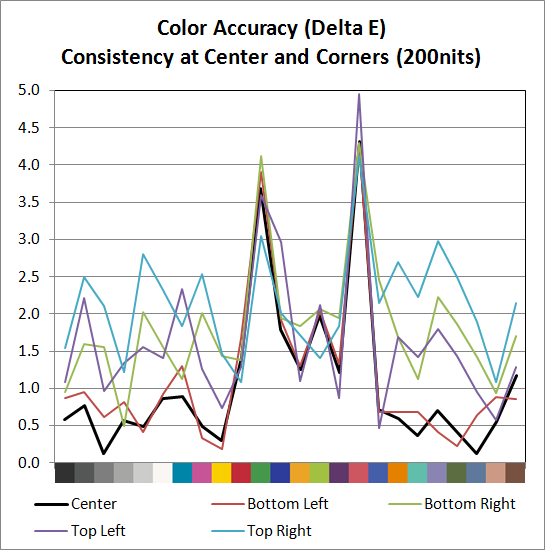
We added another test to try and measure the panel consistency across the entire surface. We measure Delta E at the center of the display, but what happens on the edges? To test this, we used the same profile generated in our best Delta E test result and measured Delta E again at the four corners. Most of the scores are similar, with a slight increase in average Delta E relative to the center measurement. The bottom-left corner is nearly identical to the center measurement, the top-left and bottom-right are a bit worse, and the top-right corner gets the overall worst result. While on the one hand we could say that the Delta E on the top-right is twice that of the center measurement, it's not a case of being "twice as bad". In fact, the color consistency is very good, and we didn't notice any "hot spots" are areas where the colors were clearly off relative to the rest of the LCD.










153 Comments
View All Comments
FlyTexas - Sunday, January 24, 2010 - link
The difference between .225 and .233 is minor, but that wasn't really my point.The 30" panels are quite a bit larger than the 27" panel here, with a higher resolution, for the same money. The 30" Dell also uses a IPS panel, and while not quite as good as this new one, it is pretty close. Close enough for most people anyway.
Actually, if you want to talk about most people, the 28" HannsG LCD is perhaps the current bargin, I picked up one for my parents before Christmas for $288 from NewEgg. Not as good as the Dell panels, but plenty good for most people.
B3an - Saturday, January 23, 2010 - link
Err yes it would. Incase you have not realised, most people do not have insanely perfect eyesight. The dot pitch on the Dell 3008 would still be kind of small for most users. Let alone this display.Having said that i would like to the day when LCD monitors have dot pitches of 2 or 3 times as much as this Dell. So the display clarity is perrrfect and non-native resolutions would also look perfect. You also would not need AA in games anymore because of how tiny each screen pixel would be.
But also have Windows automatically detect this and increase the DPI to compensate so text is just as readable.
DanaGoyette - Saturday, January 23, 2010 - link
http://members.ping.de/~sven/dpi.html">http://members.ping.de/~sven/dpi.html -- handy javascript DPI calculator. Looks like this LCD is only 108 DPI.I've always thought of reviews that say, "oh no, high dpi means fonts will be tiny!" as "reviewer fail" -- high DPI only means fonts are tiny if you don't have your OS set to correct DPI. In fact, Windows 7 now sets a correct (or at least, rounded down to the next 25% scaling) on high-dpi displays.
I have a laptop with a 1920x1200, 15.4" LCD (147dpi), and it's awesomely wonderful for my eyes -- I can run HL2DM at native resolution, and not need antialiasing. When reading text, it's "halfway to paper" (printers give at least 300 dpi). The only downside to high-dpi is that some apps do break under DPI scaling.
Unfortunately, not even ONE single desktop LCD vendor has a display with equivalent DPI rating -- in fact, many are even lower than 96 dpi! At 19 inches, 1440x900 and 1280x1024 are both around 89 DPI -- on such displays, I can easily see the individual subpixels, and such displays can give me headaches.
If I wanted a second monitor, I'd have to pay tons of money for another laptop lcd and and lcd controller board!
Also, can anyone vouch for how it compares to that HP DreamColor LCD?
FlyTexas - Sunday, January 24, 2010 - link
Even Windows 7 doesn't really fix the DPI problem, simply because so many programs are poorly coded and don't understand anything other than standard Windows DPI settings...I used to use a pair of Dell 27" displays simply because I wanted 1920x1200 at that panel size under Windows XP to allow me to see anything. Not all of us are 23 years old with perfect vision you know. :)
With Windows 7, I moved to a pair of the Dell 30" displays because they handle the resolution better, even if it isn't perfect. That, combined with 200% scaling in IE8 and I'm mostly happy.
The reason for these displays was for work purposes (work paid for them, thankfully), I can comfortably display 2 side by side pages in MS Word and they are almost exactly real size, as compared to a physical piece of paper.
The resolution isn't there, but it is good enough for editing. The benefits in gaming are just a side bonus. :)
The downsize is that too many programs (Quickbooks is a good example) just were not designed for these displays and really don't take advantage of them, nor do they scale the interface up so you're looking at tiny icons...
What do I really want?
How about a pair of 40" OLED panels running at 10240x6400. That is about 300dpi and is 4x the resolution of these 30" panels, with better display technology.
Now how much would that cost me today? ;)
BTW, that resolution is over 65 million pixels, compared to the 4 million pixels on current 30" panels (and 2 million in a 1080P display). What kind of video card would be needed to drive that?!?
The0ne - Wednesday, January 27, 2010 - link
Your first sentence is enough for anyone not to fiddle around with the DPI setting :) Thx.Gholam - Saturday, January 23, 2010 - link
And then again, people who take 22" widescreens and set them to 1024x768 greatly outnumber those who want higher DPI.dszc - Tuesday, March 2, 2010 - link
It baffles me that Microsoft, even with Windows 7, has not yet properly addressed the display size issue. Their "font scaling" simply works very poorly or not at all on many apps. This is an OS issue. Very sad.DanaGoyette - Saturday, January 23, 2010 - link
Er, by "if I wanted another LCD", I mean, if I wanted another LCD with similar DPI rating -- otherwise, a window 4 inches tall on the laptop LCD would be 6 inches tall on the desktop LCD.Gholam - Saturday, January 23, 2010 - link
Buy a used IBM T221 - 3840x2400 resolution in 22.2 inches, .1245mm pixel pitch.Iketh - Friday, January 22, 2010 - link
A good example of games that really benefit from smaller dot pitches are flight simulators. CRTs still give the best picture for these, but this Dell monitor helps close the gap.